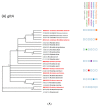Molecular Detection of Spotted-Fever Group Rickettsiae in Ticks Collected from Domestic and Wild Animals in Corsica, France
- PMID: 31487899
- PMCID: PMC6789605
- DOI: 10.3390/pathogens8030138
Molecular Detection of Spotted-Fever Group Rickettsiae in Ticks Collected from Domestic and Wild Animals in Corsica, France
Abstract
To obtain a better understanding of the current magnitude of tick-borne rickettsioses in Corsica, we used molecular methods to characterize the occurrence of Rickettsia spp. in ixodid ticks collected from domestic and wild animals. The presence of Rickettsia spp. was evaluated using real-time polymerase chain reaction targeting the gltA gene and by sequencing of gltA and ompA partial genes for species identification and phylogenetic analysis. Infection rates were calculated as the maximum-likelihood estimation (MLE) with 95% confidence intervals (CI). In total, 1117 ticks belonging to four genera (Rhipicephalus, Hyalomma, Ixodes, and Dermacentor) were collected from cattle, sheep, wild boars, and companion animals during July-August 2017 and July 2018-January 2019. Overall, Rickettsia DNA was detected in 208 of 349 pools of ticks (MLE = 25.6%, 95% CI: 22.6-28.8%). The molecular analysis revealed five different rickettsial species of the spotted-fever group (SFG). We highlighted the exclusive detection of Candidatus Ri. barbariae in R. bursa and of Ri. aeschlimanii in H. marginatum. Rickettsia slovaca was detected in D. marginatus collected from wild boars. This study provides the first evidence of the presence of Ri. monacensis in I. ricinus ticks isolated from a dog in Corsica. In conclusion, our data revealed wide dispersal of SFG Rickettsiae and their arthropod hosts in Corsica, highlighting the need for surveillance of the risk of infection for people living and/or working close to infected or infested animals.
Keywords: Corsica; Rickettsia; domestic animals; host; ticks; wild animals.
Conflict of interest statement
The authors declare that they have no competing interests.
Figures





Similar articles
-
Molecular investigation of tick-borne pathogens in ixodid ticks infesting domestic animals (cattle and sheep) and small rodents (black rats) of Corsica, France.Ticks Tick Borne Dis. 2019 Apr;10(3):606-613. doi: 10.1016/j.ttbdis.2019.02.007. Epub 2019 Feb 13. Ticks Tick Borne Dis. 2019. PMID: 30777731
-
First molecular detection of the human pathogen Rickettsia raoultii and other spotted fever group rickettsiae in Ixodid ticks from wild and domestic mammals.Parasitol Res. 2018 Nov;117(11):3421-3429. doi: 10.1007/s00436-018-6036-y. Epub 2018 Aug 4. Parasitol Res. 2018. PMID: 30078071
-
Molecular Detection and Identification of Spotted Fever Group Rickettsiae in Ticks Collected from the West Bank, Palestinian Territories.PLoS Negl Trop Dis. 2016 Jan 15;10(1):e0004348. doi: 10.1371/journal.pntd.0004348. eCollection 2016 Jan. PLoS Negl Trop Dis. 2016. PMID: 26771654 Free PMC article.
-
Spotted fever group rickettsiae in ticks in Turkey.Ticks Tick Borne Dis. 2014 Mar;5(2):213-8. doi: 10.1016/j.ttbdis.2012.11.018. Epub 2013 Nov 25. Ticks Tick Borne Dis. 2014. PMID: 24355764
-
The role of particular tick developmental stages in the circulation of tick-borne pathogens affecting humans in Central Europe. 3. Rickettsiae.Ann Parasitol. 2016;62(2):89-100. doi: 10.17420/ap6202.38. Ann Parasitol. 2016. PMID: 27614472 Review.
Cited by
-
Detecting zoonotic and non-zoonotic pathogens in livestock and their ticks in Corsican wetlands.Vet Med Sci. 2022 Nov;8(6):2662-2677. doi: 10.1002/vms3.956. Epub 2022 Oct 7. Vet Med Sci. 2022. PMID: 36207820 Free PMC article.
-
Distribution of Tick-Borne Pathogens in Domestic Animals and Their Ticks in the Countries of the Mediterranean Basin between 2000 and 2021: A Systematic Review.Microorganisms. 2022 Jun 16;10(6):1236. doi: 10.3390/microorganisms10061236. Microorganisms. 2022. PMID: 35744755 Free PMC article.
-
Dermacentor marginatus and Dermacentor reticulatus, and Their Infection by SFG Rickettsiae and Francisella-Like Endosymbionts, in Mountain and Periurban Habitats of Northwestern Italy.Vet Sci. 2020 Oct 16;7(4):157. doi: 10.3390/vetsci7040157. Vet Sci. 2020. PMID: 33081422 Free PMC article.
-
Lack of Evidence for Crimean-Congo Hemorrhagic Fever Virus in Ticks Collected from Animals, Corsica, France.Emerg Infect Dis. 2022 May;28(5):1035-1038. doi: 10.3201/eid2805.211996. Emerg Infect Dis. 2022. PMID: 35447051 Free PMC article.
-
First detection of Jingmen tick virus in Corsica with a new generic RTqPCR system.Npj Viruses. 2024 Sep 30;2(1):44. doi: 10.1038/s44298-024-00053-1. Npj Viruses. 2024. PMID: 40295835 Free PMC article.
References
-
- Hornok S., Csorgo T., de la Fuente J., Gyuranecz M., Privigyei C., Meli M.L., Kreizinger Z., Gonczi E., Fernandez de Mera I.G., Hofmann-Lehmann R. Synanthropic birds associated with high prevalence of tick-borne rickettsiae and with the first detection of Rickettsia aeschlimannii in Hungary. Vector Borne Zoonotic Dis. 2013;13:77–83. doi: 10.1089/vbz.2012.1032. - DOI - PubMed
Grants and funding
LinkOut - more resources
Full Text Sources
Miscellaneous

